On May 20, the Arizona Diamondbacks and San Diego Padres faced off. This game didn’t have any significant meaning, other than Chris Paddack and Luke Weaver were matched up. I’m sure you’re well familiar with both, but Paddack is a phenom with a filthy fastball-changeup combo who’s looking to develop his curveball, while Weaver is a young pitcher who is just 26 and also has a strong fastball-changeup tandem, while also looking for a third pitch. They both were friendly surprises in 2019, and I think you’d be surprised how deep the similarities between the two go.
That’s not to say that they’re identical. They’re not. I love Paddack—I wrote a glowing article about him in early May—but I’d argue that we should be less starry-eyed with Paddack and rosier on Weaver in 2020. Weaver had a UCL scare in 2019, and those concerns are perfectly legitimate, but Paddack has had Tommy John surgery already. In any case, there is overlap between the two.
Their repertoires, by movement:
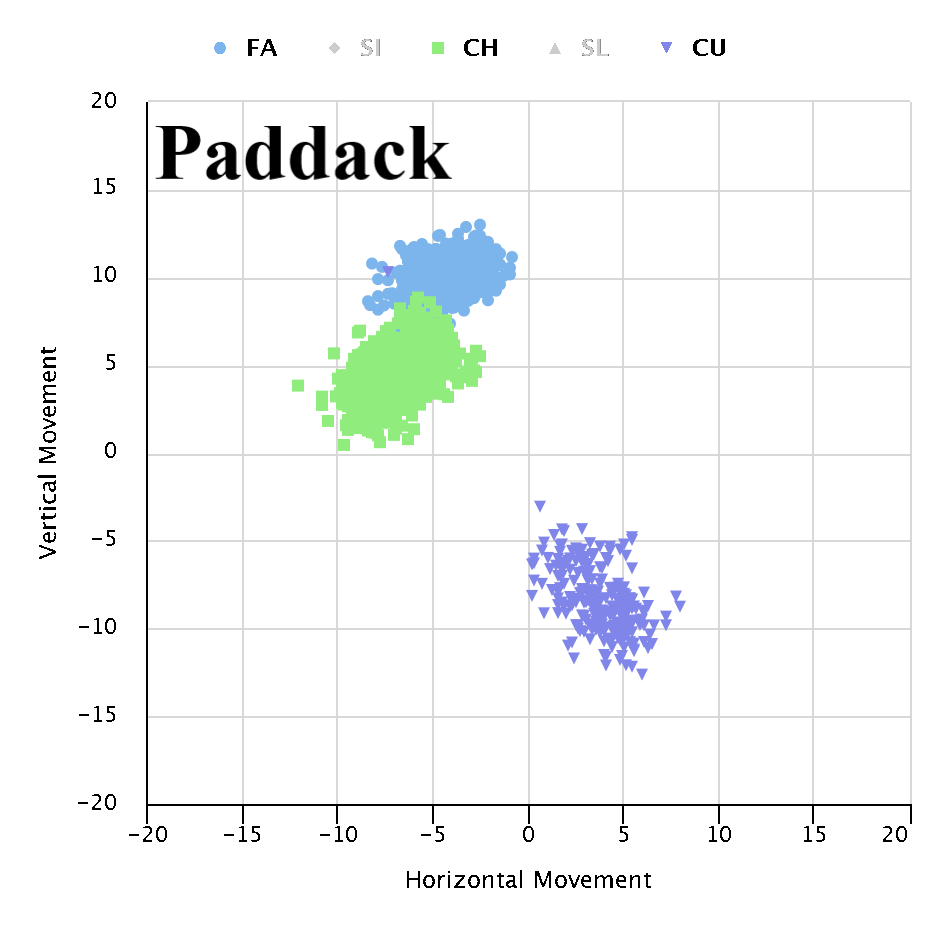
By velocity, spin rate, and movement, their fastballs and changeups (which we’re focusing on) are strikingly similar. Paddack has a superior fastball—the difference is that Paddack’s fastball has much more active spin, which gives it more “rise.” For this reason, he’ll always have the better fastball, but their changeups are pretty close, by movement and results, and they both have curveballs that have a lot of vertical drop and not a lot of horizontal movement.
For this reason, it perhaps comes as no surprise that they have a similar approach. From their May 20 duel:
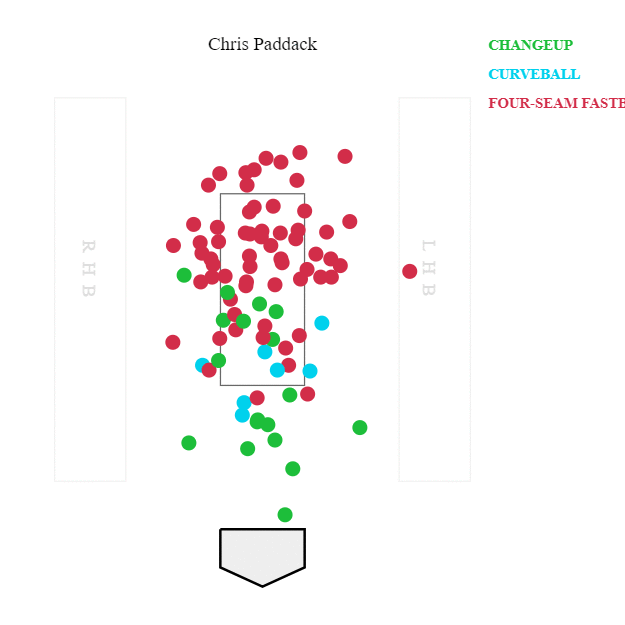
Paddack does a significantly better job consolidating his pitches, and there are fewer “wasted” pitches, but their overall framework is the same. While Weaver is dotting in and out with his fastball more, I’d say it’s as follows: fastball up, changeup low on his arm side or below the zone, and curveballs mixed in.
Weaver has always been one to pitch away from hitters, regardless of handedness, with his fastball. Like many pitchers, it would be to his benefit to elevate his fastball—especially to his arm side.
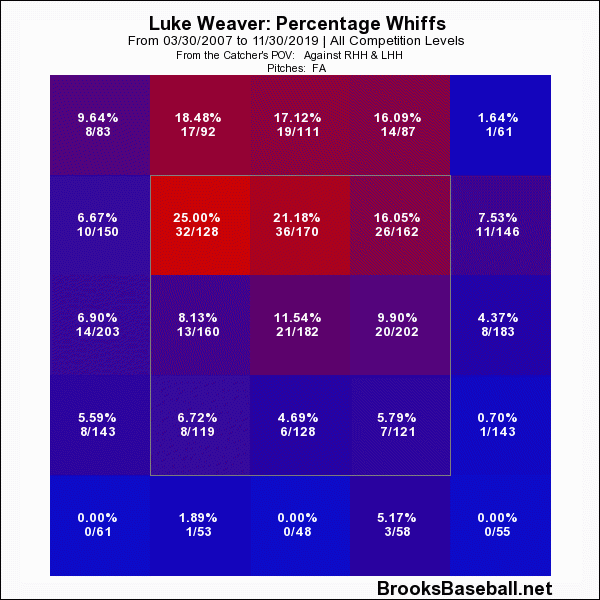
Even Paddack’s fastball doesn’t play that well at the top of the zone. Above the zone, yeah, Paddack’s fastball is far superior, but Weaver is missing out on a ton of whiffs because of his tendency to pitch away rather than pitch up. It’s certainly easier said than done, but with his command, I imagine Weaver is better able to make such a change than most pitchers. In any case, things are working out pretty well as is.
| O-Swing% | Contact% | Zone% | SwStr% | GB% | pVAL | |
|---|---|---|---|---|---|---|
| Weaver FF | 24.8 | 85.7 | 54.3 | 8.0 | 38 | 3.2 |
| Paddack FF | 29.1 | 80.2 | 62.1 | 10.2 | 28.2 | 13.5 |
| Weaver CH | 43.2 | 74.2 | 32.8 | 18.3 | 48.2 | 6.7 |
| Paddack CH | 48.4 | 72.4 | 36.7 | 16.5 | 54.3 | 8.8 |
| Weaver CU | 24.6 | 71 | 28.1 | 9.4 | 36.4 | -0.9 |
| Paddack CU | 26.1 | 83.2 | 40.6 | 6.3 | 32.4 | -0.6 |
| Weaver FC | 22.6 | 83.6 | 57.8 | 8.2 | 42.3 | 2.1 |
Right away, we can see similarities and discrepancies. Paddack, again, has the better fastball, but their changeups are pretty similar. Both curveballs aren’t very good, but at the bottom of the table, you’ll find that Weaver has found a workable cutter.
Weaver’s rolling cutter usage, strikeout percentage, and swinging-strike percentage:
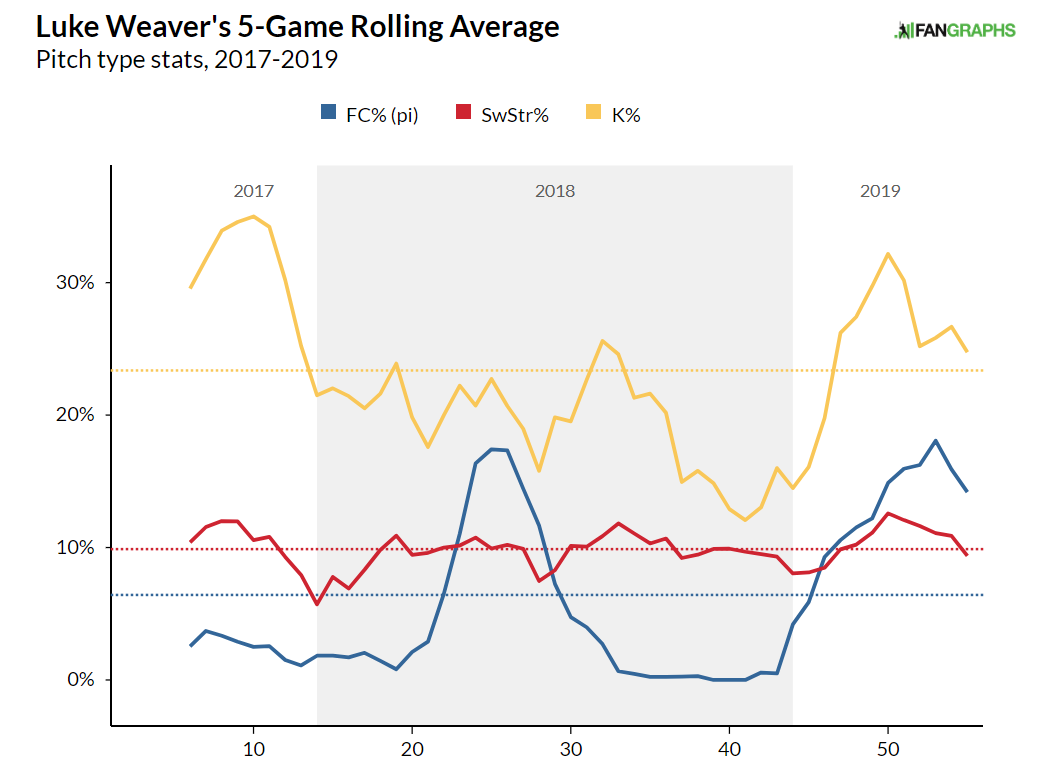
Correlation isn’t causation, but it seems that there is a relationship between Weaver’s cutter and his improvements. The cutter itself isn’t a world-beating pitch. In fact, compared to other cutters and sliders with similar velocity and movement, it’s a little underwhelming. Nonetheless, the cutter gives him a swing-and-miss pitch against righties that he can throw in the zone.
I repeat: His cutter gives him another pitch he can throw in the zone. With a zone percentage of 57.8%, it gives him a pitch along with his fastball that can be featured in the zone more than half of the time and won’t get beaten up. In fact, his cutter’s zone percentage is higher than his fastball’s, which is 54.3%. So, yes, his cutter isn’t the best pitch, but it’s been about as effective as his fastball, which is a solid pitch.
| O-Swing% | Contact% | Zone% | SwStr% | pVAL/C | |
|---|---|---|---|---|---|
| Four-seamer | 24.8 | 82.0 | 54.3 | 8.0 | 0.6 |
| Cutter | 22.6 | 83.6 | 57.8 | 8.2 | 1.5 |
Given that its properties didn’t change, it’s not entirely clear what caused his cutter to grow. Really, by velocity, movement, and location, it didn’t change much. His cutter’s spin rate decreased by a tad, and it sounds like he was planning on thinking less and throwing it with more conviction. I think the latter two are huge reasons for his growth, but his new curveball may have something to do with it too.
Like his cutter, his curveball is improved. Unlike his cutter, Weaver sought out advice from Adam Wainwright on what constitutes a good curveball and bought a Rapsodo to reshape it over the offseason.
Weaver’s pitch movement, plotted by velocity and horizontal movement, 2018 versus 2019:
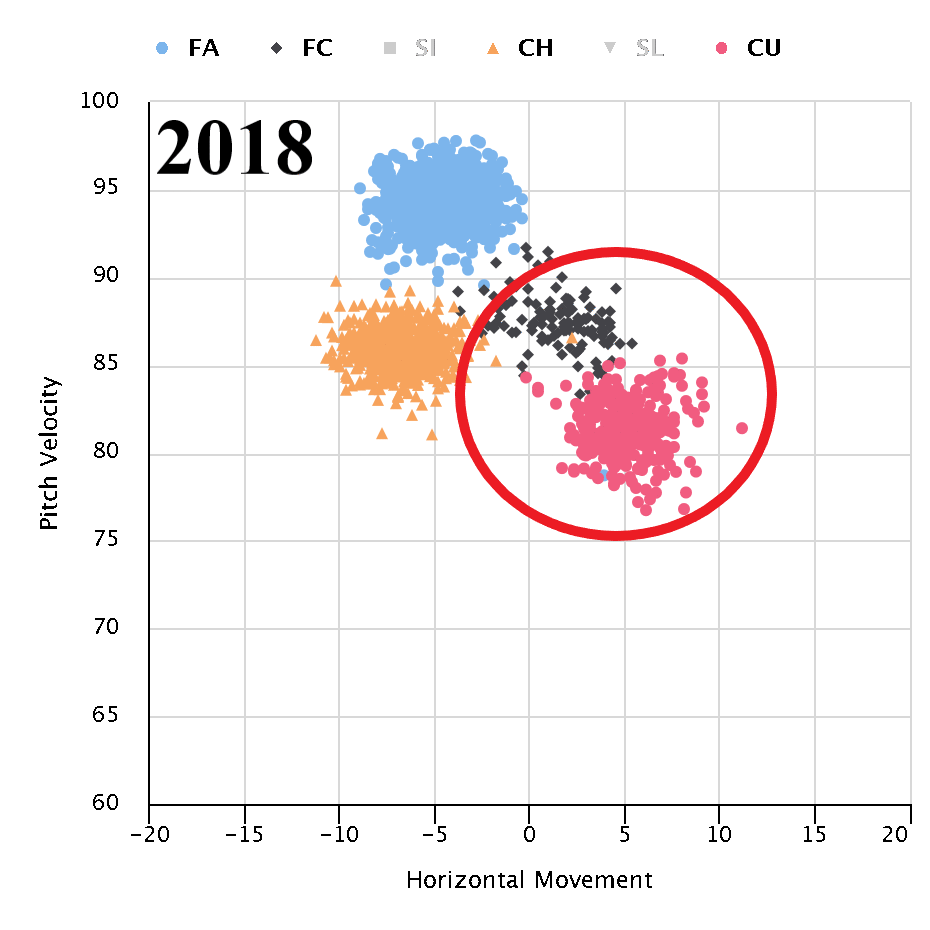
Clearly, you can see that he’s successfully reshaped his curveball. While it has plenty of horizontal movement before, it has almost none now. It’s retained its velocity while changing into more of a 12-6 shape. As Craig Edwards noted, drop is a much more efficient use of Weaver’s curveball (which lacks spin) than run is.
Chipping away at a story about Luke Weaver for @baseballpro. Spoke with the righty on the DBacks recent road trip in Chicago about the changes to his repertoire.
Below is an overlay of his cutter (⬆️ usage from 2018), changeup and curveball from a recent start in Atlanta. #MLB pic.twitter.com/fM0jHiyPrH
— Lance Brozdowski (@LanceBroz) April 27, 2019
While it has less glove-side movement than his cutter, Weaver’s curveball has become more of a “changeup,” or slow version, to his cutter. That’s one explanation: His pitches play off one another better than they did before. I think there’s truth to that—they bear more resemblance than before, but I think what has helped Weaver is becoming less of a helicopter parent of his cutter, as he puts it. Instead of trying to turn it into more of a cutter, or more of a slider, he’s throwing it with conviction and letting it decide for itself.
The result? Let’s look again, first by release point:
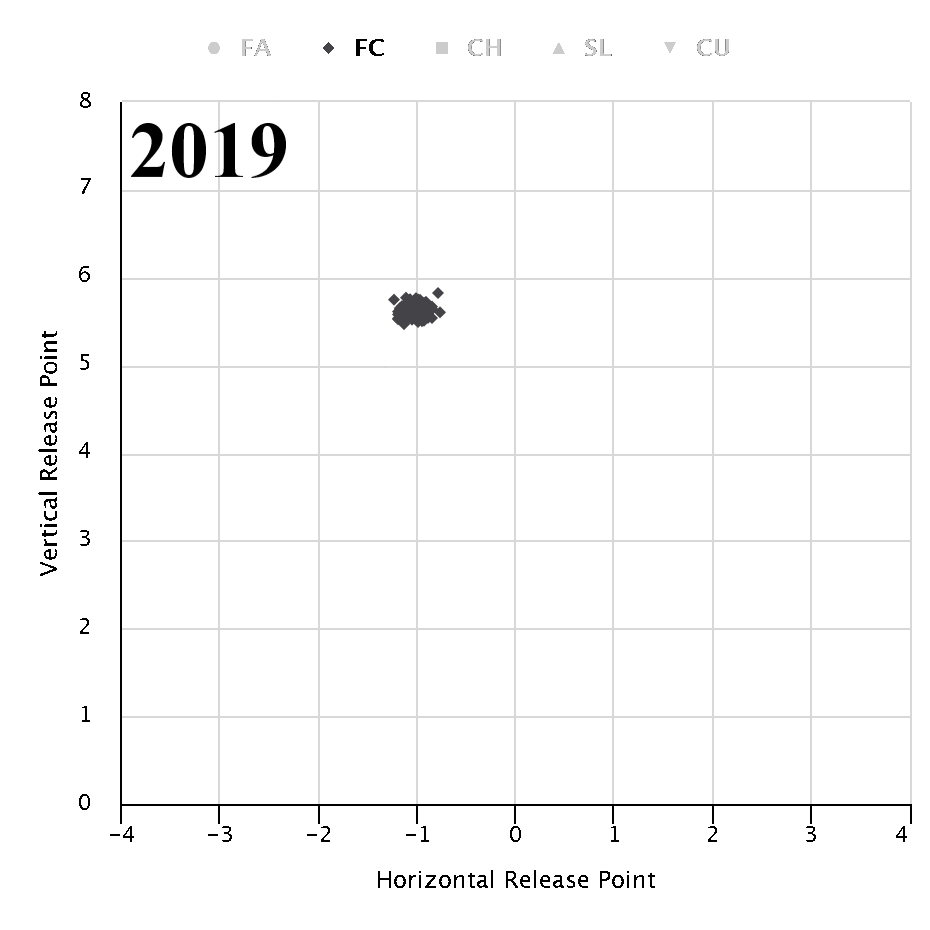
And then by pitch movement:

Weaver significantly tightened up the release point of his cutter, and the movement of his pitches tightened up as well. It’s logical, then, to think that he’d improve his command of the pitch too.
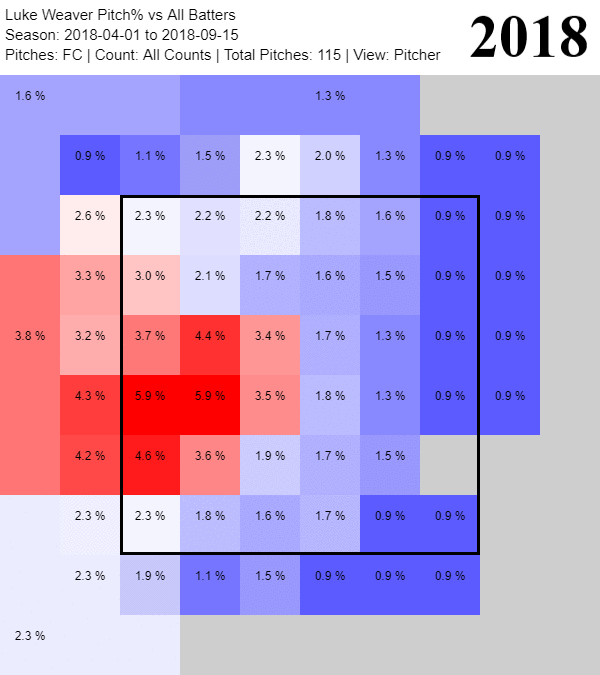
Yup. Compared to his cutter location before, he’s sharpened it by quite a bit. This has resulted in more pitches in the zone, and he’s been able to use it to play off his curveball and changeup as you saw in the tweet above. In 2018, just his curveball had a strike percentage of over 30%. In 2019, his fastball, cutter, and curveball all crossed the 30% threshold. That matters.
Despite my optimism for Weaver’s changes—and I will go on record to say that I think they are legitimate—they do not come without (potentially) significant caveats. Most prominently, Alex Chamberlain has developed what he is tentatively calling “xwOBA tru” on a beta version of his pitch leaderboard. In short, it’s the formula for xwOBA, but he has substituted xK% and xBB% in place of K% and BB%, respectively. Again, there are going to be players who inherently underperform and overperform this metric (yet again) due to the nature of their profiles, but these can be sussed out by examining why there are discrepancies between their numbers.
Filtering by wOBA minus xwOBA tru, Weaver is atop the leaderboard with a -.054. That doesn’t bode well for him, as it suggests that, rather than his .279 wOBA being legitimate, he is more like a .334 wOBA pitcher who was fortunate in K% (he overperformed by about 4%), BB% (he overperformed by about 4%), and batted-ball luck (which, is true—he was). Despite this, I am inclined to believe that, while a 5% walk rate may be low, I don’t think Weaver is a 9 BB% pitcher. One reason is the fact that he throws his four-seamer and cutter in the zone quite a bit, and even though his changeup isn’t thrown in the zone that often, it gets hitters to chase nearly 50% of the time. Further, his career K% is 2.4 percentage points higher than his xK%, and his BB% is 1.9 points lower than his xBB%.
I think there’s a lot to like with Weaver, but we should certainly approach him with cautious optimism. After all, if his xwOBA tru is, well, true, then Weaver is still a below-average starting pitcher, as is. I wish I could say with greater certainty, but Weaver threw just 64.1 innings on the year, which is hardly enough to say that he’s a changed pitcher.
The package is all here. Weaver already has a plus fastball-changeup combo, and now it seems that he’s got a third pitch he can throw in the zone with regularity. His curveball is still a work in progress—and unlocking that could be a huge boon—but for now, we should feel good about Luke Weaver. He has above-average command of all four of his pitches, and while he may not have Paddack’s upside, it looks like he has one thing that Paddack doesn’t: a third pitch. And a fourth isn’t out of the question. Let’s not forget he’s just 26.
(Photo by Tim Spyers/Icon Sportswire)


Aw man – this is just an amazing article. I love this stuff. I would like to see more articles describing how a pitch may complement (or aggravate) a pitcher’s repertoire… there is a lot of value to be had there! Alex Wood has always been my favorite example – he has this loopy change-up that can follow up or set up both his fastball or curve… hitters never know what is coming.
Do you mind doing a 2021 rank of the following mid-tier pitchers?
Luke Weaver
Caleb Smith
Zach Gallen
Max Fried
Dylan Cease
Thanks!
Thanks John! I find this type of analysis fascinating as well.
I assume you meant 2020, but my ranking would be as follows (with Nick’s rankings in parentheses):
Gallen (31) — Four pitches, two of which are plus, with command that could improve. Has several pitches to induce whiffs.
Weaver (55) — Finally has a third pitch and will continue to work on that and his curveball. Nice floor with upside. Doesn’t have the same amount of pitches to get swings and misses as Gallen.
Smith (48) — Is his fastball velocity going to be back? Was hurt and lost two ticks on his fastball throughout the year. When healthy, he can be a top 25 pitcher (I just worry that he won’t be.)
Fried (60) — Has a +SL and +CU to give with his fastball that’s good enough if he pitches fastballs up and SL/CU down. (Could throw it less, though!) The changeup could develop too.
Cease (74) — Walks too many hitters and gives up too many home runs. His fastball hasn’t been very good considering how much velo it has. Would greatly benefit from throwing more breaking and offspeed stuff.
Thanks for reading!